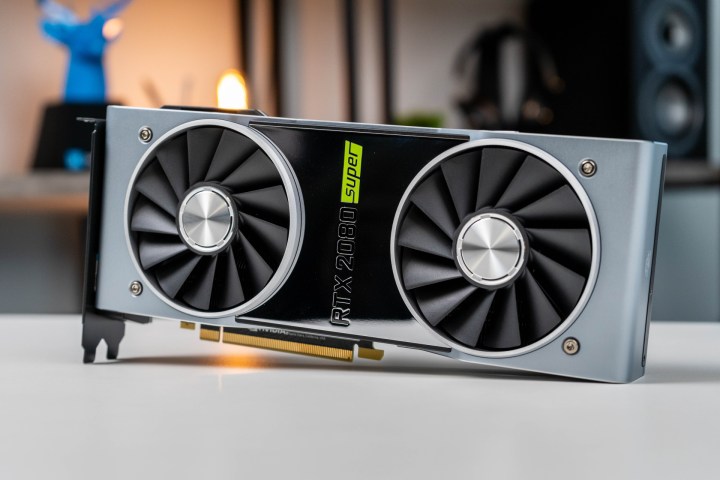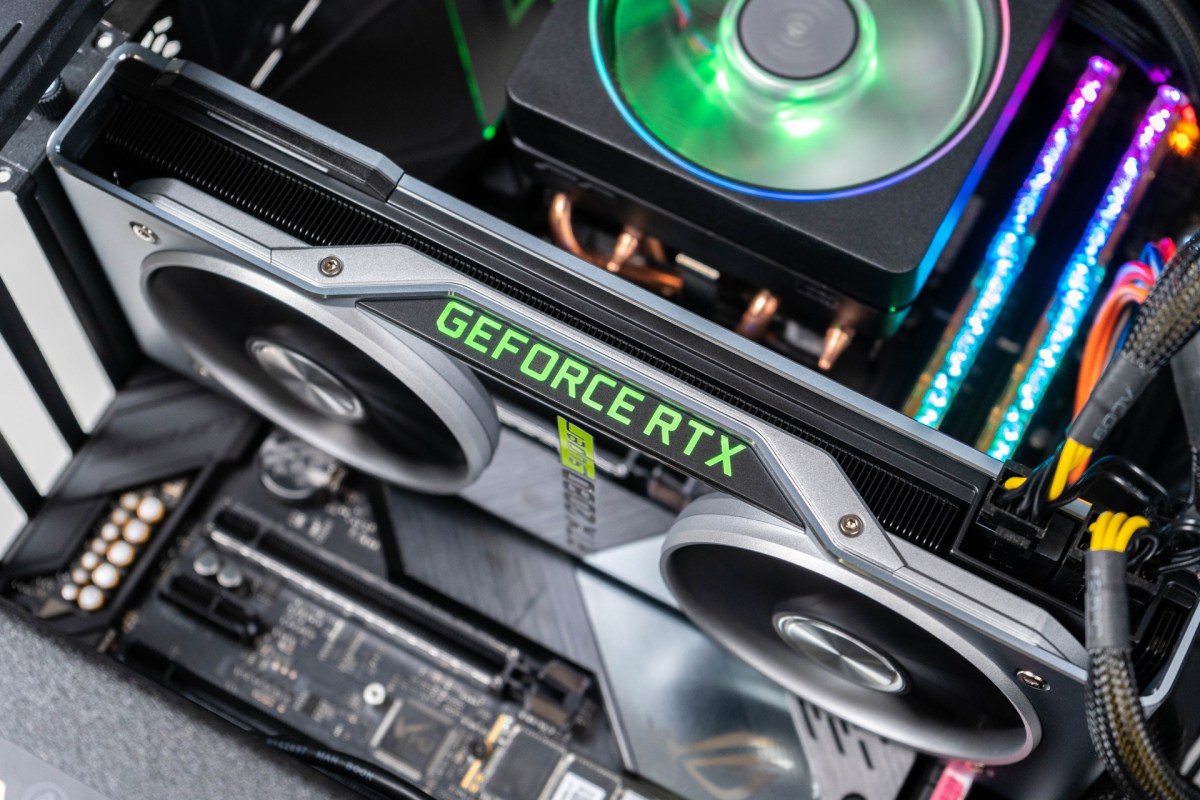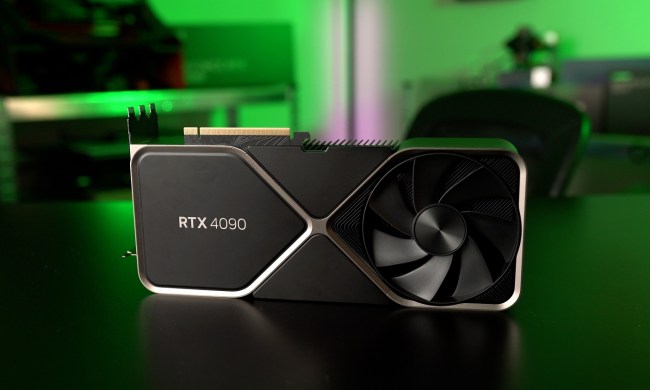
Nvidia doesn’t need the RTX 2080 Super right now.
Whatever challenge AMD’s RX 5700-series graphics may have presented to Nvidia’s mid-range cards, the RTX 2080 and 2080 Ti were untouched. The original RTX 2080 already beat the Radeon VII. The RTX 2080 Ti sits at the top of the stack without a rival.
But with the ‘Super’ series taking the place of the original RTXs, Nvidia has rearranged its lineup. The RTX 2080 Super feels like a “why not?” product. If you can push offer more performance, why not?
It’s totally superific
The RTX 2080 Super looks nearly identical to other RTX Super cards, distinguished only by the reflective surface between the two fans and the green “Super” logo. It’s a large card, without a doubt, but the same size as the RTX 2070, and is powered by the same 8-pin/6-pin PCI power connector combo on the side. That’s unlike the RTX 2060 Super and 2060, which use a 6-pin/4-pin combo and include a VGA port. Both the 2080 Super and 2070 Super include HDMI ports, three DisplayPort connections, and a USB-C VirtualLink port for VR headsets.
Nvidia’s Turing architecture is the heart of the RTX 2080 Super. First released in the fall of 2018, Turing is the follow-up to the well-loved Pascal architecture that powered the popular GTX 10-series. The new focus is, of course, the Tensor cores and RT cores, which give these RTX cards fancy ray tracing and AI capabilities. Here’s how the 2080 Super fits in the lineup.
| RTX 2080 Ti | RTX 2080 Super | RTX 2080 | RTX 2070 Super | RTX 2070 | RTX 2060 Super | RTX 2060 | |
| GPU | TU102 | TU104 | TU104 | TU104 | TU106 | TU106 | TU106 |
| CUDA cores | 4,352 | 3,072 | 2,944 | 2,560 | 2,304 | 2,176 | 1,920 |
| Tensor cores | 544 | 384 | 368 | 320 | 288 | 272 | 240 |
| RT Cores | 68 | 48 | 46 | 40 | 36 | 34 | 30 |
| Base clock | 1,350MHz | 1,650MHz | 1,515MHz | 1,605MHz | 1,410MHz | 1,470MHz | 1,365Mhz |
| Boost clock | 1,545MHz | 1,815MHz | 1,710Mhz | 1,770MHz | 1,620MHz | 1,650MHz | 1,680MHz |
| Memory | 11GB GDDR6 | 8GB GDDR6 | 8GB GDDR6 | 8GB GDDR6 | 8GB GDDR6 | 8GB GDDR6 | 6GB GDDR6 |
| Memory speed | 14 Gbps | 15.5Gbps | 14Gbps | 14Gbps | 14Gbps | 14Gbps | 14Gbps |
| Bandwidth | 616 GBps | 496GBps | 448GBps | 448GBps | 448GBps | 448GBps | 336GBps |
| TDP | 250w | 250w | 215w | 215w | 175w | 175w | 160w |
| Price | $1,199 | $699 | $799 | $499 | discontinued | $399 | $349 |
The RTX 2080 Super replaces the old RTX 2080, dropping the price by $100 while retaining the TU104 GPU. That GPU is now shared with the RTX 2070 Super. A performance “squeeze” on the RTX 2080 Super provides a slight bump across the board, increasing everything from clock speeds to core counts. It’s nothing too notable, offering an 8% upgrade in base clock speed over the RTX 2080.
In short, the RTX 2080 Super is a slightly better RTX 2080 that sells for $100 less. That’s not a bad elevator pitch.
However, the RTX 2080 Super’s lags a bit behind the upgraded found in the RTX 2070 and 2060 Super. The other Super cards gain a roughly 10% spec bump over their predecessors, while the 2080 Super only sees a 4% upgrade. That ensures the RTX 2080 Super is not threat to the RTX 2080 Ti, which remains the fastest RTX card Nvidia offers.
Most notable among 2080 Super’s changes in an increase in memory speed, bandwidth, and TDP. Will that make a difference in performance? Let’s find out.
Super gaming, right?
We tested all these cards in the same exact rig, of course, which included an Intel Core i9-9900K, 16GB of RAM, and an M.2 solid state drive.
We always start GPU tests with 3DMark’s Time Spy benchmark. It’s a DirectX 12 test that provides a fairly realistic representation of how modern games will perform on your rig. The RTX 2080 Super makes a jump over the non-Super RTX 2080, though it’s about what you’d expect.
The RTX 2080 Super earns a 4% advantage over the RTX 2080, while the 2080 Ti is still a solid 13.5% ahead of the RTX 2080 Super. While it’s true the RTX 2080 Super lands between the two cards, it’s much closer to the weaker of the two. This might be disappointing if you were expecting the RTX 2080 Super to replace the RTX 2080 Ti — it’s nowhere close to doing that.
Frankly, Nvidia didn’t need the RTX 2080 Super. The RTX 2080 already beat the Radeon VII by a healthy 18%. To add insult to injury, the 2080 Super extends that lead up to 21%. Ouch. Meanwhile, the 2080 Super stays 10% ahead of the 2070 Super, creating just enough space in the lineup to justify the existence of both.
The 2080 Super maintains those leads in real-world gaming, as it turns out. Unfortunately, the roughly 4% increase in performance only adds up to a few extra frames per second in most titles.
I took the 2080 Super for a spin across our standard array of test games: Civilization VI, Fortnite, Battlefield V, and Assassin’s Creed Odyssey. You can expect a high-end card like the RTX 2080 Super to produce over 60 FPS in almost all games, even at 4K resolution with maxed out graphics settings. If you have a high refresh rate monitor, you can enjoy blisteringly fast framerates at1080p or 1440p.
The results in context of the competition, however, didn’t mark a clear, decisive win for RTX 2080 Super. Out of the four games, it was only in Fortnite where the 2080 Super provided a noticeable leap up in framerates. Across 1080p, 1440p, and 4K, it held a steady 15% increase over the RTX 2080. That’s what I like to see.

The other three games, though, were a mixed bag. The 2080 Super held the typical 4% lead in Civilization VI in all resolutions and graphic settings. But in Assassin’s Creed Odyssey, the 2080 and 2080 Super were nearly identical in both 1080p and 1440p. Only at 4K did the 2080 Super eek out an extra 6% performance.
As expected, the only game the Radeon VII beats the RTX 2080 Super in is Battlefield V. For whatever reason, it’s a game AMD hardware handles better, and here it stays a few frames per second ahead of Nvidia at every resolution tested.
It’s still expensive, but does it even matter?
The RTX 2080 Super isn’t terribly exciting, though only because we tested other RTX Super cards first. The RTX 2070 and 2060 Super were an impressive leap over their predecessors. The RTX 2080 Super tip-toes carefully forward.
Don’t forget the $100 price cut from the RTX 2080 (Founders Edition), however, which is no small matter. The RTX 2080 Super represents the new standard for high-end gaming cards, and it offers a better dollar-per-FPS value than the RTX 2080 did last year.
Most gamers should pick up the RTX 2070 Super, which is a better value overall. The RTX 2080 Super is 29% more expensive, but its performance is no better than 10% more. There’s very little the RTX 2080 Super can do that it’s little sibling can’t, so you may notice the difference.
Still, if you’re willing to pay for it, the RTX 2080 Super still delivers the best gaming performance in a graphics card you can get under $1,000. Nvidia’s RTX 2080 Super isn’t the graphics card you need, but it’s the one you’ll want.







